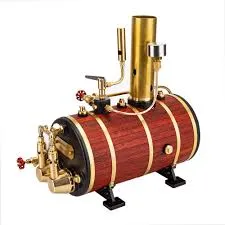
Des . 06, 2024 07:24 Back to list
steam engine boiler design
The Design of Steam Engine Boilers An Overview
The steam engine revolutionized the world during the Industrial Revolution, marking a significant transition in transportation and manufacturing. Central to the functionality of steam engines is the boiler, a critical component that generates steam by converting water into vapor through the application of heat. The design of steam engine boilers has evolved significantly over time, reflecting advancements in technology, materials, and safety protocols. This article provides an overview of the key aspects involved in steam engine boiler design.
Historical Context
The origins of steam boiler design can be traced back to the early 18th century with Thomas Newcomen's atmospheric engine and later, James Watt's enhancements. Early boilers, such as the Newcomen engine, were simple in design but had significant limitations. They utilized a straightforward cylindrical shape and relied on external fire sources to heat water. As demand for increased efficiency grew, so did the complexity of boiler designs. The introduction of high-pressure boilers in the 19th century allowed steam engines to become more powerful and efficient, paving the way for advances in rail and maritime transportation.
Types of Boilers
There are two primary types of steam boilers fire-tube and water-tube boilers. Each serves the same fundamental purpose—producing steam—but does so through differing mechanisms.
1. Fire-Tube Boilers In these designs, hot gases produced from combustion pass through tubes submerged in water. The heat transfer from the gases to the water generates steam. Fire-tube boilers are typically used in smaller applications due to their relatively lower pressure and capacity limitations.
2. Water-Tube Boilers In contrast, water-tube boilers have water contained in tubes that are heated by hot gases on the outside. This design allows for higher pressures and greater steam production, making them suitable for larger industrial applications. Water-tube boilers tend to be more efficient and have faster response times compared to fire-tube boilers.
Key Design Considerations
steam engine boiler design

When designing a steam engine boiler, several critical factors must be taken into account to ensure efficiency, safety, and reliability
1. Material Selection The choice of materials is crucial for boiler construction, as they must withstand high temperatures and pressures. Common materials include carbon steel, alloy steel, and stainless steel. Each material has its own thermal conductivity, strength, and resistance to corrosion, which must align with the specific operational requirements of the boiler.
2. Pressure Rating The design pressure of the boiler determines its operational capability. Boilers are classified according to their pressure ratings, including low-pressure (up to 15 psi) and high-pressure (above 15 psi) systems. High-pressure boilers must incorporate rigorous safety measures to handle the potential risks associated with high-temperature steam.
3. Thermal Efficiency The efficiency of a boiler is defined by its ability to convert fuel into energy with minimal losses. Design elements such as economizers, superheaters, and heat exchangers can be integrated to improve thermal efficiency by recovering waste heat and optimizing combustion processes.
4. Safety Features Safety remains a paramount concern in boiler design. Features such as pressure relief valves, water level indicators, and automatic shut-off systems are critical for preventing catastrophic failures. Regular maintenance and adherence to safety codes and standards, such as the ASME Boiler and Pressure Vessel Code, are essential in ensuring long-term operational safety.
5. Environmental Considerations In recent years, there has been a growing emphasis on the environmental impact of boiler operations. Modern design practices now include strategies for reducing emissions and enhancing efficiency to comply with environmental regulations. Technologies such as flue gas recirculation and advanced combustion controls contribute to minimizing the ecological footprint of steam engines.
Conclusion
The design of steam engine boilers is a complex interplay of historical evolution, technological advancement, and stringent safety considerations. As steam technology continues to adapt to changing energy landscapes, the development of efficient and safe boiler designs remains a vital area of engineering. From simple fire-tube designs to sophisticated water-tube systems, boiler technology plays an indispensable role in harnessing steam for various applications, ensuring its relevance in modern industrial practices. Ultimately, the continuous innovation in boiler design will help meet the increasing demand for energy while addressing environmental concerns, thus preserving the legacy of steam power for future generations.
-
High-Efficiency Commercial Oil Fired Steam Boiler for Industry
NewsJul.30,2025
-
High-Efficiency Biomass Fired Thermal Oil Boiler Solutions
NewsJul.30,2025
-
High Efficiency Gas Fired Thermal Oil Boiler for Industrial Heating
NewsJul.29,2025
-
High-Efficiency Gas Fired Hot Water Boiler for Sale – Reliable & Affordable
NewsJul.29,2025
-
High Efficiency Biomass Fired Hot Water Boiler for Industrial and Commercial Use
NewsJul.29,2025
-
High-Efficiency Biomass Fired Hot Water Boiler for Industrial Use
NewsJul.28,2025
Related PRODUCTS






















